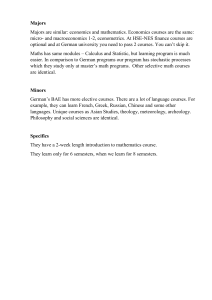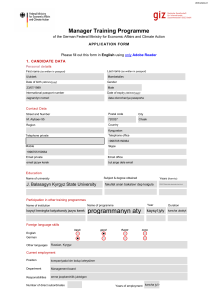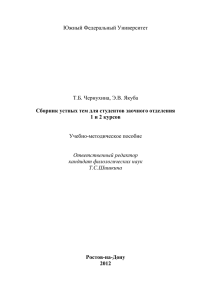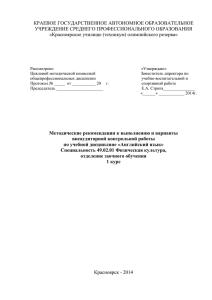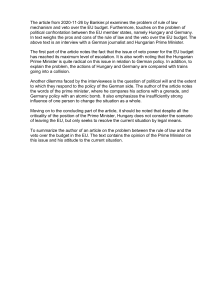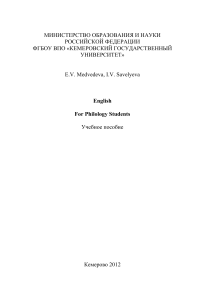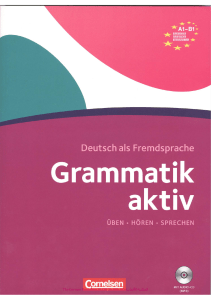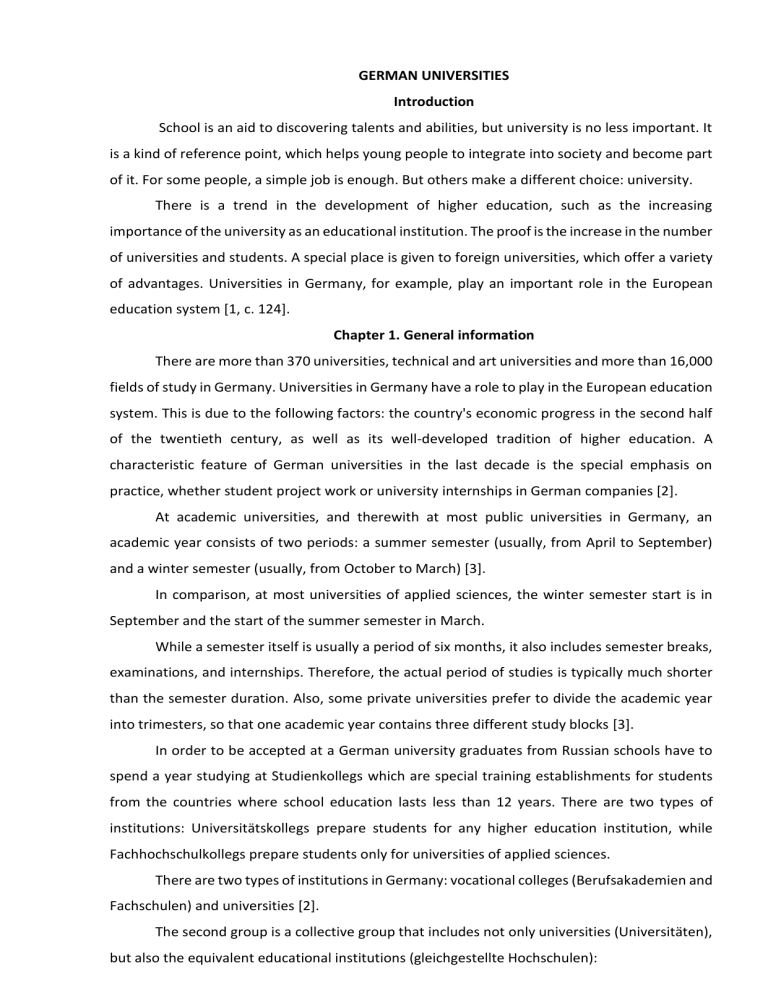
GERMAN UNIVERSITIES Introduction School is an aid to discovering talents and abilities, but university is no less important. It is a kind of reference point, which helps young people to integrate into society and become part of it. For some people, a simple job is enough. But others make a different choice: university. There is a trend in the development of higher education, such as the increasing importance of the university as an educational institution. The proof is the increase in the number of universities and students. A special place is given to foreign universities, which offer a variety of advantages. Universities in Germany, for example, play an important role in the European education system [1, с. 124]. Chapter 1. General information There are more than 370 universities, technical and art universities and more than 16,000 fields of study in Germany. Universities in Germany have a role to play in the European education system. This is due to the following factors: the country's economic progress in the second half of the twentieth century, as well as its well-developed tradition of higher education. A characteristic feature of German universities in the last decade is the special emphasis on practice, whether student project work or university internships in German companies [2]. At academic universities, and therewith at most public universities in Germany, an academic year consists of two periods: a summer semester (usually, from April to September) and a winter semester (usually, from October to March) [3]. In comparison, at most universities of applied sciences, the winter semester start is in September and the start of the summer semester in March. While a semester itself is usually a period of six months, it also includes semester breaks, examinations, and internships. Therefore, the actual period of studies is typically much shorter than the semester duration. Also, some private universities prefer to divide the academic year into trimesters, so that one academic year contains three different study blocks [3]. In order to be accepted at a German university graduates from Russian schools have to spend a year studying at Studienkollegs which are special training establishments for students from the countries where school education lasts less than 12 years. There are two types of institutions: Universitätskollegs prepare students for any higher education institution, while Fachhochschulkollegs prepare students only for universities of applied sciences. There are two types of institutions in Germany: vocational colleges (Berufsakademien and Fachschulen) and universities [2]. The second group is a collective group that includes not only universities (Universitäten), but also the equivalent educational institutions (gleichgestellte Hochschulen): universities of applied sciences (Fachhochschulen); Technical universities (Technische Universität); schools of art and music (Kunst- und Musikhochschulen); medical universities (Medizinische Hochschulen); theological universities (Theologische Hochschulen); Universities of Teacher Education (Pädagogische Hochschulen). Chapter 2. Advantages and disadvantages 2.1 The advantages of German universities. Focus on innovation Majority of institutions in Germany have a strong focus on academic research and technological inventions. Innovation is perceived as the driver of the global economy and academics are provided with important stimulus for continuous progress – 80 German Nobel prize laureates serve as confirmation of that. Strong partnership networks Getting accepted to a German university often means entering a vast network of partnerships with a lot of educational opportunities. German universities cooperate with different institutions worldwide and are offering international exchange and dual degree programmes, as well as other important partnerships. Such cooperation allows broadening academic and learning experience of students. International programmes Germany gives a lot of importance to the international exchange which is widely supported by institutes of higher education. Universities in Germany welcome international students from all over the world which account for approximately 12% of the total number of students in Germany. At the same time, students here are encouraged to go abroad for a certain time during their studies. Long-established traditions Even though most of the universities in Germany today follow the modern scientific approach, it does not mean giving up on long, successful tradition that was born and built upon over centuries. Starting with the first German university in Heidelberg, which was founded in 1386, an educational culture has developed here. Regulation of German education Education in Germany is regulated at the level of each individual federal state with local acts and guidelines meaning there is no nation-wide legislation. Moreover, universities are given a lot of authority to define their own policies, as well as admission and application processes. Types of German universities There are three different types of German universities that you need to consider when planning your education path abroad: Academic universities Theoretical knowledge and methodological expertise are known to be the ground basis of programmes taught at academic universities, regardless of the course chosen. Another characteristic feature is the possibility to do a doctorate, which is usually not possible at other types of higher education institutions. Universities of applied sciences Otherwise known as “Fachhochschulen”, those universities have a strong focus on the practical side of learning and professional practice. The range of subjects taught at those institutions usually covers such areas as business, technology, social work, and medicine. An important part of those academic programmes is a so-called “Praxissemester” – a work placement for the period of one or several semesters at companies in Germany or abroad. Colleges of art and music Those institution types offer study courses for future musicians and artists that aim to become professionals in their fields. While certain institutions deliver a whole range of subjects in arts, others choose to focus on a specific area like music or design [3]. 2.2 The disadvantages of German universities. High entrance requirements Even for admission to the preparatory year of study, students are required to confirm their knowledge of the German language at a level not lower than B2. According to the reviews of all applicants, the entrance exam at Studienkolleg is unexpectedly difficult, and, as a result, not everyone succeeds in passing it the first time. This entails the loss of the whole academic year since documents can be submitted again after six months or even after a year if the selected university has only one set of deadlines. Assessment of previous education German universities pay close attention to the subjects passed at the baccalaureate level and their relevance to the master's program. Most of the refusals upon admission occur precisely because of the inconsistency of the previous education of the applicant with the profile of the program. Translation and legalization of documents German universities set strict requirements for accepted translations of application documents, as well as their legalization in different authorities. These rules must be followed in order not to receive a refusal due to technical inaccuracy alone. Limited number of English programs German universities offer an extremely limited number of undergraduate programs in English, thereby creating huge competition for admission [3]. Chapter 3: Leading universities in Germany Charles University in Prague The first German-language university in medieval Europe was Charles University in Prague, then part of the Austro-Hungarian Empire. Until the end of the 19th century, teaching was in German; today, students can attend lectures in Czech and English. Studying at Charles University in the Czech Republic is free, a year of English language tuition costs between 500 USD to 15,000 USD. The average budget is about 5,000 USD per year, including food, accommodation (about 200 USD per month), study materials, entertainment and transport. Financial support is available for international students and is provided separately by each department. As a rule, most of them provide scholarships for academic merit (from 300 USD to 1,000 USD annually) or according to social criteria. For studies in English, scholarships are only available to students in doctoral programmes [4]. Heidelberg University Today Heidelberg University (Ruprecht-Karls-Universität Heidelber), Germany's oldest university, offers more than 60 Bachelor's and Master's degree courses, grouped into four large groups: 1. Science, Mathematics and Informatics (Naturwissenschaften, Mathematik und Informatik); 2. Humanities and Theology (Geisteswissenschaften und Theologie); 3. Law, Economics and Sociology (Jura, Wirtschafts- und Sozialwissenschaften); 4. Medicine (Medizin). Studying at Heidelberg University is free, but students pay a semester fee of 12,650 USD. This money goes into the student fund and is eventually redistributed to the student him or herself: the student receives student benefits, travel and other privileges. Student housing costs around 250 USD per month. The University of Heidelberg offers several financial aid schemes for its students. The main opportunity that a foreigner can count on is the scholarship of the German government Deutschlandstipendium. It is awarded to students with the highest academic achievements and amounts to 300 USD per month. In addition, certain faculties (astrophysics, art history and others) may offer other scholarships for PhD and Master's students [4]. University of Tübingen The coziest university, Tübingen is one of Germany's top five "student" cities, with a large student population of around 25,000. The University of Tübingen (Eberhard Karls Universität Tübingen) enjoys particular fame in the natural sciences, medicine and theology, and in recent years has also attracted large numbers of international students - not only because of its high rankings and special focus on economic programs, but also because of the special atmosphere of the southern campus and student life. Studying at the University of Tübingen is free of charge, but all students must pay a regular administrative fee of 14,380 USD per semester, which entitles them to benefits for transport, dormitories and some cafés. Living in a student residence costs approximately 5,000 USD per year. Students have the chance to receive scholarships or grants from various sources (German Government, German or international organisations and independent foundations). The University of Tübingen doesn’t have its own scholarship programme [4]. Conclusion Therefore, German universities have a number of advantages which still attract potential students from all over the world. There is a saying in the German language "Wer die Wahl hat, hat die Qual", which literally means "Those who have a choice are spoilt for choice". Most former foreign university students in Germany believe that an education in Germany, or rather the decision to study there, was the right thing to do. Indeed, a large number of positive arguments have previously been uncovered in favour of this decision. 1. Торохова, Н. Е. Университет как социальный институт. Современное состояние / Н. Е. Торохова // Система ценностей современного общества. – 2011. – № 21. – С. 124-127. 2. Universities in Germany / Текст : электронный // UNIPAGE : [официальный сайт]. – URL: https://www.unipage.net/en/universities_germany (дата обращения: 06.01.2022). 3. Higher education system and types of universities in Germany / Текст : электронный // Fintiba : [официальный сайт]. – URL: https://www.fintiba.com/moving-to-germany/studying/universities/universitysystem/#success-factors (дата обращения: 06.01.2022). 4. Мытник, О.С. Das Studium in Deutschland / О.С. Мытник // Мультиурок : [официальный сайт]. – URL: https://demo.multiurok.ru/blog/das-studium-indeutschland.html (дата обращения: 06.01.2022).
